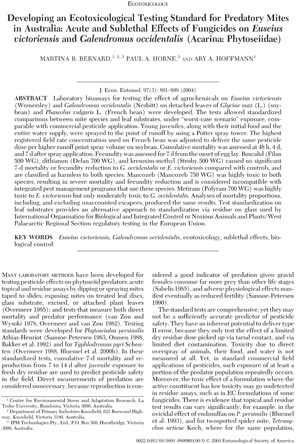|
|
Many laboratory methods have been developed for testing pesticide effects on phytoseiid predators. The standard tests are comprehensive, yet they may not be a sufficiently accurate predictor of pesticide safety. The aim of this research was to develop a simple, economically viable laboratory test for :
A topical bioassay exposing young E. victoriensis and G. occidentalis juveniles on detached leaves, evaluating direct mortality and sublethal effects, was used to investigate the effect of five fungicides for control of Plasmopara viticola and Phomopsis viticola Saccardo in grapevines, and fungal diseases in pome fruit, citrus, and other crops.
Abstract : Laboratory bioassays for testing the effect of agrochemicals on Euseius victoriensis (Womersley) and Galendromus occidentalis (Nesbitt) on detached leaves of Glycine max L. (soybean) and Phaseolus vulgaris L. (French bean) were developed. The tests allowed standardized comparisons between mite species and leaf substrates, under “worst-case scenario” exposure, comparable with commercial pesticide application. Boscalid (Filan 500 WG), dithianon (Delan 700 WG), and kresoxim-methyl (Stroby 500 WG) caused no significant 7-d mortality or fecundity reduction to G. occidentalis or E. victoriensis compared with controls, and are classified as harmless to both species. Mancozeb (Mancozeb 750 WG) was highly toxic to both species, resulting in severe mortality and fecundity reduction and is considered incompatible with integrated pest management programs that use these species. Metiram (Polyram 700 WG) was highly toxic to E. victoriensis but only moderately toxic to G. occidentalis. These findings provide a starting point for standardized ecotoxicological testing of phytoseiids in Australia. Testing could be extended to more species, particularly those resistant to the widely used wettable sulfur based products. Modifications may include testing juveniles of a more narrow age range. Acknowledgements : We thank David Evans Walterand Jennifer J. Beard for generosity in teaching phytoseiid taxonomy. James A. Altmann for advice in field collecting and rearing and for supply of mites. Dan F. Papacek and PeterJ. Kelly for encouragement and comments on the manuscript. Janyce Truett, William Bigand, and David Bennett for aspects of technical support. The Australian Grape and Wine Research and Development Corporation for funding this work. The Victorian Department of Primary Industries Knoxfield for providing a research facility And the many Australian wine grape growers who helped initiate this research. |
|

